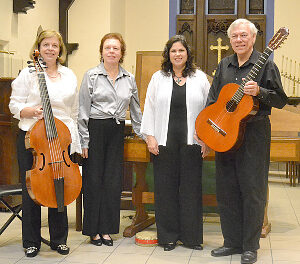Performing the complete output of a composer’s genre, or for that matter, all-encompassing presentations in any of the arts is, at best, a double-edged sword. It runs the gamut from reveling in it, to a “too much of a good thing” weariness. Local concertgoers had the chance over the past weekend to experience all or part of the complete piano trios of Beethoven in three separate concerts. The Triangle cities of Chapel Hill, Durham and Raleigh hosted the Abegg Trio in what was indeed a rare opportunity. Presented by the Chamber Arts Society as one part of the annual “September Prelude” kickoff of the fall chamber music season, I attended the middle concert at Duke University’s Reynolds Theater.
Ulrich Beetz, violin, Birgit Erichson, cello, and Gerrit Zitterbart, piano, formed the Abegg Trio in 1976 and, if not a record, have certainly enjoyed a longevity of personnel and success that would be the envy of most ensembles. Unfortunately, for those of us in the U.S., this group is not widely known both because of their relatively rare travels here and the extremely sparse American distribution of their many recordings. In fact, an amazon.com search comes up with only two hits — both imports and from the mid 90s. So, this was my first exposure to a veteran, well-established group, and I came away with an uneven impression.
So as to not favor one of the three concerts over the other, both for artistic and ticket-sales reasons, artists and presenters did their best to balance each program into roughly a shorter variations-based trio, an early work, and one of the more mature big-named compositions. The opener was the wonderfully named “Kakadu” variations, which, although published late in Beethoven’s life, is more of a middle-period work. The music world was awash with operatic melodies, many of them justifiably long forgotten, that served as the basis for displaying composers’ skills in variation techniques. Bravura technique along with an almost schmaltzy irreverence and abandon are necessary to bring life to these insipid melodies. There was little life or sense of fun brought to this Kakadu. While arpeggios, scales, and other technique-building aids are the building blocks of these variations, there was no conveyance to the audience that it was anything but so many notes.
The second part of Ludwig’s first published opus is certainly meatier than the opening work and its symphonic structure and length was a departure from what was your run-of-the-mill piano trio of the time. The problems from the first work became even more pronounced in this longer trio. There seems to be a “Goldilocks” approach to musicians’ behavior while they play. Some people decry excessive animation and emotional display in traditional chamber music. Here we had the complete other extreme — an almost totally rigid, physically uninvolved persona by all. That, by itself, may be a red herring, but the music being heard sounded like how they looked. Perhaps being the middle piece of the middle concert of an exhausting trip played a part, but my overall impression was one of palpable ennui. The perkier movements had more life and involvement in them, but slower movements require more focus and these became serviceable, earnest run-throughs. While pianist Zitterbart was reliable and forceful in a piano-heavy score, cellist Erichson’s presence was timid and careful, even in the relatively few passages where the cello part should shine. Violinist Beetz displayed sure-handed intonation but his playing on the high “e” string was often shrill, almost whiny — a most unattractive sound whether it emanates from teenagers or string players.
There was a very noticeable energy boost in the second half along with what would generally be considered a much more musically satisfying composition. The Opus 70, No.1 trio is subtitled “Ghost” primarily because of the somewhat creepy-crawly nature of the slow middle movement. Here we have Beethoven at the height of his powers and it brought the playing alive. More attention was given to heightened dynamic contrasts, which is part of what gives Beethoven’s music its power. The final Presto movement had some erratic and unstable rhythms among the three players, but that can be overlooked when they are swinging and their minds are not on vacation. Automatic pilot just does not work for music.
The encore was the central section of the Trio in E-flat, WoO (without opus) 38, a delightful movement with an obvious nod to Haydn. They, and we, were having fun now — wish there was more of that earlier.
Note: For a Letter to the Editor concerning this review and its two companions (9/7 & 9/9/07), click here.












